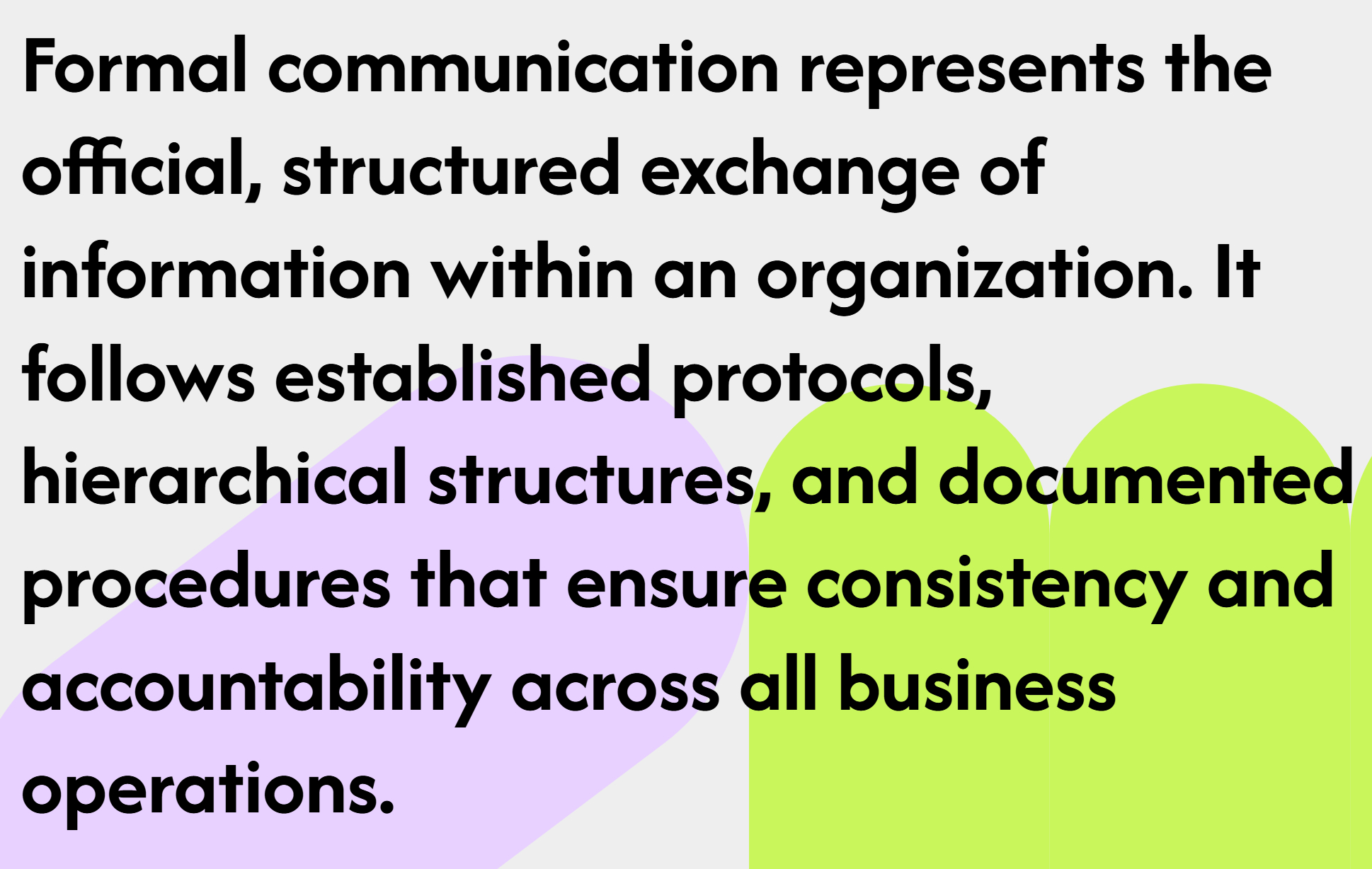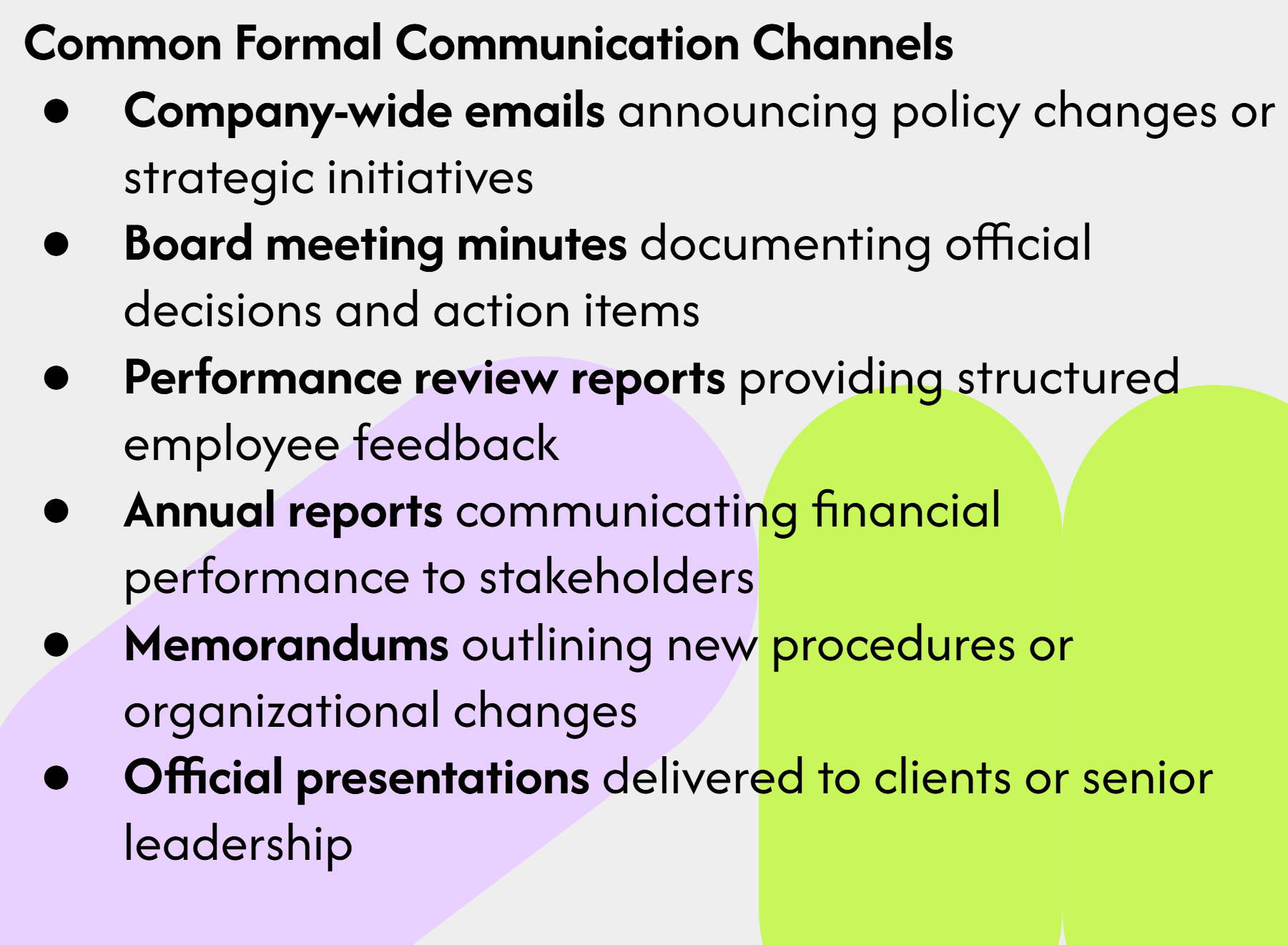Understanding Communication Types
Understanding what is formal informal communication is crucial for workplace success. Every day, professionals navigate between structured official channels and spontaneous personal interactions. The choice between these communication styles can make or break your career progression, team relationships, and overall organizational effectiveness.
Recent workplace studies show that 67% of communication breakdowns stem from using the wrong communication style for the situation. This guide explores both formal and informal communication methods, helping you master when and how to use each approach effectively.
Whether you're a new employee learning workplace norms or a seasoned manager refining your communication strategy, knowing what is formal informal communication will transform your professional interactions and boost your career success.
What is Formal Communication?
Formal communication represents the official, structured exchange of information within an organization. It follows established protocols, hierarchical structures, and documented procedures that ensure consistency and accountability across all business operations.

Key Characteristics of Formal Communication
Hierarchy-Based Structure: Formal communication flows through predetermined organizational channels. Information moves vertically (top-down or bottom-up) through the chain of command, ensuring proper authority and approval processes.
Documentation Requirements: Every formal communication creates a permanent record. This documentation serves multiple purposes: legal protection, policy reference, performance tracking, and accountability measures.
Professional Standards: Formal communication maintains consistent tone, language, and formatting standards. This standardization ensures clarity and professionalism across all organizational levels.
Official Business Focus: These communications address company policies, strategic decisions, performance reviews, legal matters, and other official business that requires precision and authority.
Common Formal Communication Channels
- Company-wide emails announcing policy changes or strategic initiatives
- Board meeting minutes documenting official decisions and action items
- Performance review reports providing structured employee feedback
- Annual reports communicating financial performance to stakeholders
- Memorandums outlining new procedures or organizational changes
- Official presentations delivered to clients or senior leadership
What is Informal Communication?
Informal communication encompasses spontaneous, unofficial information exchange that occurs naturally between individuals. Unlike formal channels, informal communication prioritizes relationship-building, creativity, and rapid information sharing over strict protocols.
Key Characteristics of Informal Communication
Spontaneous Nature: Informal communication happens naturally without predetermined schedules or formal invitations. These interactions emerge from immediate needs, personal relationships, or shared interests.
Relationship-Focused: The primary goal extends beyond information transfer to building trust, rapport, and personal connections that strengthen team dynamics and organizational culture.
Flexibility and Speed: Without formal approval processes, informal communication allows for quick decision-making, immediate feedback, and rapid problem-solving that keeps projects moving forward.
Multidirectional Flow: Information moves freely across departments, hierarchical levels, and organizational boundaries, creating networks that bypass traditional command structures.
Common Informal Communication Channels
- Hallway conversations discussing project updates or sharing quick insights
- Team messaging apps like Slack or Microsoft Teams for instant collaboration
- Lunch break discussions mixing work topics with personal relationship-building
- Coffee meetings providing relaxed environments for brainstorming and feedback
- Social media interactions between colleagues extending workplace relationships
Key Differences Between Formal and Informal Communication
Understanding what is formal informal communication requires recognizing their fundamental differences across multiple dimensions:
Structure and Flow Patterns
Formal Communication: Follows rigid hierarchical structures with clearly defined approval processes. Information must pass through appropriate channels and authority levels before reaching its destination.
Informal Communication: Creates flexible network structures where information flows freely between individuals regardless of their organizational position or departmental affiliation.
Documentation and Record-Keeping
Formal Communication: Requires comprehensive documentation for legal compliance, policy reference, and accountability purposes. Every message creates a permanent organizational record.
Informal Communication: Rarely generates permanent records, relying instead on personal memory and relationship-based trust for information retention and follow-up actions.

Purpose and Intent
Formal Communication: Serves official business purposes including policy communication, legal compliance, performance management, and strategic decision-making that requires authority and precision.
Informal Communication: Focuses on relationship-building, creative collaboration, quick problem-solving, and cultural development that enhances team cohesion and organizational flexibility.
Tone and Language Standards
Formal Communication: Maintains professional, standardized language with consistent formatting and tone across all organizational levels to ensure clarity and authority.
Informal Communication: Allows conversational, personalized language that reflects individual personalities while maintaining workplace appropriateness and respect.
Real-World Examples
Formal Communication Examples
Policy Announcement Email: "Dear Team Members, Effective January 1st, 2025, our remote work policy will be updated to include new hybrid scheduling requirements. Please review the attached document and confirm your understanding by December 15th."
Performance Review Report: "Employee demonstrates consistent achievement of quarterly targets with 15% above-average performance in client satisfaction metrics. Recommended development areas include advanced project management certification."
Board Meeting Minutes: "Motion approved unanimously to allocate $2.5 million for technology infrastructure upgrades. Implementation timeline: Q2 2025. Project lead: Director of IT Operations."
Informal Communication Examples
Team Chat Message: "Hey everyone! Just wrapped up the client call - they loved our proposal! Pizza party tomorrow to celebrate? 🍕"
Hallway Conversation: "I noticed you're working late on the Morrison project. Need any help with the data analysis? I have some spare time this afternoon."
Lunch Discussion: "What do you think about the new marketing campaign? I have some ideas that might work well with your design approach."
When to Use Each Type
Mastering what is formal informal communication means knowing when each approach serves your professional goals most effectively.
Choose Formal Communication When:
Legal or Compliance Issues: Any communication involving legal requirements, regulatory compliance, or potential liability issues requires formal documentation and approval processes.
Policy Changes: Organizational policy updates, procedure modifications, or strategic direction changes need formal communication to ensure consistency and accountability.
Performance Management: Employee evaluations, disciplinary actions, promotions, or terminations require formal documentation for legal protection and organizational records.
External Stakeholder Communication: Client proposals, investor updates, vendor negotiations, or partnership agreements need formal professionalism and documentation.
Choose Informal Communication When:
Brainstorming Sessions: Creative thinking, idea generation, and innovative problem-solving benefit from informal communication's flexibility and spontaneity.
Team Building: Relationship development, trust-building, and cultural integration flourish in informal communication environments that encourage personal connection.
Quick Updates: Immediate information sharing, status updates, or minor clarifications work better through informal channels that avoid bureaucratic delays.
Collaborative Projects: Cross-functional teamwork, creative partnerships, and innovative initiatives thrive with informal communication's networking capabilities.
Best Practices for Success
Formal Communication Best Practices
Clarity and Precision: Use clear, specific language that eliminates ambiguity. State your purpose upfront and provide necessary context for understanding.
Appropriate Channels: Choose the right formal channel for your message. Email works for most announcements, while meetings suit complex discussions requiring immediate feedback.
Professional Formatting: Maintain consistent formatting, proper grammar, and professional tone. Use templates when available to ensure organizational consistency.
Timely Follow-up: Establish clear deadlines and follow-up procedures. Formal communication requires accountability and measurable outcomes.
Informal Communication Best Practices
Respect Boundaries: Maintain professional appropriateness even in casual settings. Personal relationships should enhance, not replace, professional standards.
Active Listening: Focus on understanding others' perspectives and building genuine connections. Informal communication succeeds through authentic engagement.
Cultural Sensitivity: Recognize that informal communication varies across cultures and individuals. Adapt your approach to respect different comfort levels and communication styles.
Strategic Networking: Use informal communication to build professional relationships that support your career goals and organizational objectives.
Common Mistakes to Avoid
Formal Communication Mistakes
Over-Complexity: Avoid unnecessary jargon, lengthy explanations, or complex procedures that obscure your main message. Keep formal communication clear and actionable.
Delayed Responses: Formal communication requires timely responses and follow-through. Delays can damage credibility and organizational efficiency.
Inconsistent Messaging: Ensure all formal communications align with organizational policies and previous messages. Inconsistency creates confusion and undermines authority.
Informal Communication Mistakes
Inappropriate Casual: Don't let informal communication become unprofessional. Maintain respect and workplace appropriateness in all interactions.
Excluding Team Members: Informal communication should enhance team dynamics, not create exclusive groups that damage morale and collaboration.
Replacing Formal Channels: Never use informal communication for matters requiring formal documentation or official approval processes.
Conclusion
Understanding what is formal informal communication provides the foundation for workplace success in today's dynamic business environment. Both communication styles serve essential purposes: formal communication ensures organizational structure, accountability, and legal compliance, while informal communication builds relationships, drives innovation, and enhances team collaboration.
The most successful professionals master both approaches, seamlessly transitioning between formal and informal communication based on situational needs, audience requirements, and organizational culture. They recognize that effective communication isn't about choosing one style over another, but about strategically combining both methods to achieve their professional goals.
Remember that what is formal informal communication extends beyond simple categorization. It's about building communication competence that adapts to your audience, respects organizational culture, and achieves your intended outcomes. Whether you're drafting an official policy memo or engaging in a casual brainstorming session, your communication choices directly impact your career success and organizational effectiveness.
Start implementing these insights today. Evaluate your current communication patterns, identify opportunities for improvement, and begin practicing the strategic use of both formal and informal communication in your workplace interactions. Your enhanced communication skills will drive better relationships, clearer understanding, and greater professional success.
Ready to transform your workplace communication? Start by assessing your current communication style and identifying one area for improvement. Small changes in how you communicate can lead to significant career advancement and team success.
